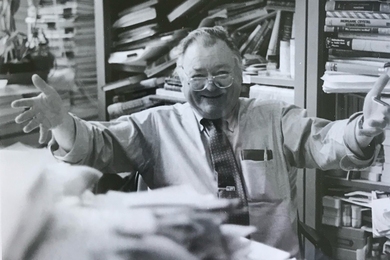CAMBRIDGE, Mass. Mar. 13--Attorneys for the Massachusetts Institute of Technology said today that the first-in-the-nation "stranded cost" tariff against MIT's new cogeneration plant was based on inflated revenue figures that are at least three times what the Cambridge Electric Light Co. (CELCo) now states in an affidavit to be its maximum loss of revenue.
The stranded cost or "customer transition charge" amounts to a $3,500 a day ($1.3 million a year) penalty for power MIT does not receive. The MIT attorney, John DeTore, said the figures revealed in a recent CELCo affidavit calls into question the entire factual basis of CELCo's case that a customer transition charge was needed. MIT has kept CELCo informed throughout the 10-year planning process for the MIT plant.
MIT became the first cogeneration plant in the nation to be penalized with a stranded cost charge last Sept. 29, when the Massachusetts Deparment of Public Utilities (DPU) approved CELCo's request for a "customer transition charge" of $1.3 million a year for an indefinite period, subject to review after CELCo and its affiliate, COM/Electric, submit their proposed rates in August under the state-wide restructuring of the electric power industry.
The charge was based on CELCo statements that they would need an average increase of more than six percent on other customers in order to make up for the loss of MIT revenues. However, in a recent affidavit to the DPU, CELCo stated the revenue loss was only two percent.
The idea behind the unprecedented charge is to allow a utility to recover, from the owners of a new cogeneration plant, the out-of-pocket "stranded cost" of power commitments the utility allegedly made in anticipation of that customer continuing to get its power from the utility, and which the utility cannot otherwise sell or avoid incurring.
"The stranded cost tariff written by CELCo is an outrage. It is almost pure profit to CELCo," DeTore said. "Massachusetts law requires that electric rates, whether for apartment dwellers or a college, must be 'just and reasonable.' This customer transition charge which CELCo wrote does not meet that standard."
MIT yesterday filed a response in its petition to the state DPU regarding the legal interpretation of the customer transition charge.
DeTore, in an interview, said today, "CELCo's affidavit of March 4, 1996 demonstrates that there will be no appreciable impacts on rate payers in granting MIT's petition. The worst-case scenario presented by CELCo is a potential 2.06 percent revenue loss, one-third of the loss the company had claimed before." DeTore said CELCo's worst-case scenario "contains several dubious assumptions" which significantly overstate even the 2.06 percent revenue loss. For example, CELCo's rate specialist acknowledges that growth of electric use will increase their revenues by $1.6 million.
But contrary to a Feb. 16 DPU decision - which said all such increases should offset the loss- the CELCo rate specialist said only 32% of the increase should offset CELCo's alleged loss from the MIT plant.
CELCo PRESIDENT'S TESTIMONY
CELCo, while not detailing its power commitment costs, sought the customer transition charge on the basis of CELCo President Russell Wright's testimony that the loss of the MIT plant "would cause rates of remaining customers to increase by more than six percent." The concern over CELCo's estimate of "an average rate increase of over 6%" was cited by DPU Commissioner Janet Besse in her concurring opinion on Sept. 29, 1995. "MIT submits that an adjudication of this issue would likely result in a demonstration of minimal, if any, revenue loss to the Company," said DeTore, an attorney with Rubin & Rudman of Boston. He esti-mated that without the stranded cost charge, the revenue loss at most would be only 2/10ths of one percent at most.
DeTore said, "The question is how much the Company (CELCo) will enrich itself at MIT's expense." An MIT affidavit shows that MIT will pay about $1.2 million more a year if the Department denies its petition dealing with the issue of tariff interpretation, which was not resolved in the original case. "Under any reasonable scenario, the Company will only make an additional profit from MIT," he said.
"Most likely, the Company will reap the benefits of the entire $1.2 million at MIT's expense. This will increase the Company's rate of return on equity ($6 million last year) by approximately 20 percent. Surely, this is not what the DPU intended in its order," DeTore said.
CONTRARY TO DPU DECISION OF FEB. 16
DeTore noted in MIT 's petition to the DPU that the CELCo "approach is directly contrary to that used by the Department (DPU) in its Feb. 16, 1996 decision involving Stow Municipal Electric Department" and the Hudson Light & Power Dept., a municipal utility which was denied a "stranded cost" charge because it failed to show its actual costs.
ENVIRONMENTAL BENEFITS
MIT's 20 megawatt plant is powered by a natural gas turbine engine to produce electricity. The resulting hot exhaust gases are used to produce steam in a heat-recovery generator, an energy-efficient technology that is 18 percent more efficient than generating electricity and steam independently. The gas-fired cogeneration plant benefits the environment by reducing MIT's pollutant emissions by 45 percent, equal to reducing auto traffic in Cambridge by 13,000 round trips per day.
FEDS LEAVE CALCULATION OF CHARGE TO STATE
On Feb. 29, the Federal Energy Regulatory Commission (FERC) ruled that the customer transition charge, which applies only to MIT's cogeneration power plant, is not discriminatory under the Public Utility Regulatory Polices Act of 1978, which encouraged organizations to develop cogeneration plants. The FERC did not rule on whether the customer transition charge was properly calculated; it left that issue to the state DPU and the state courts.
MIT is also in the process of appealing the customer transition charge to the Massachusetts Supreme Judicial Court, where it may be determined whether the amount is excessive, according to Victoria V. Sirianni, MIT director of physical plant.
"There's some passion in our feeling," commented Ms. Sirianni, "that from a public policy perspective, when the Federal government encourages conserving energy and doing with less, we shouldn't be penalized for doing precisely that. It's unfortunate that our power plant, after several years of construction, went on line just at the time the electric power industry is about to be restructured."
GAS SUPPLIER IS A CELCo AFFILIATE
MIT's plant is powered by natural gas, which will be supplied by a CELCo affiliate, Commonwealth Gas. CELCo, COM/Electric and Commonwealth Gas are subsidiaries of COM/Energy. CELCo will still supply about 25% of MIT's total electricity needs
CELCo has agreed that it will return money to MIT if a judgment is made in MIT's favor on the customer transition charge.





